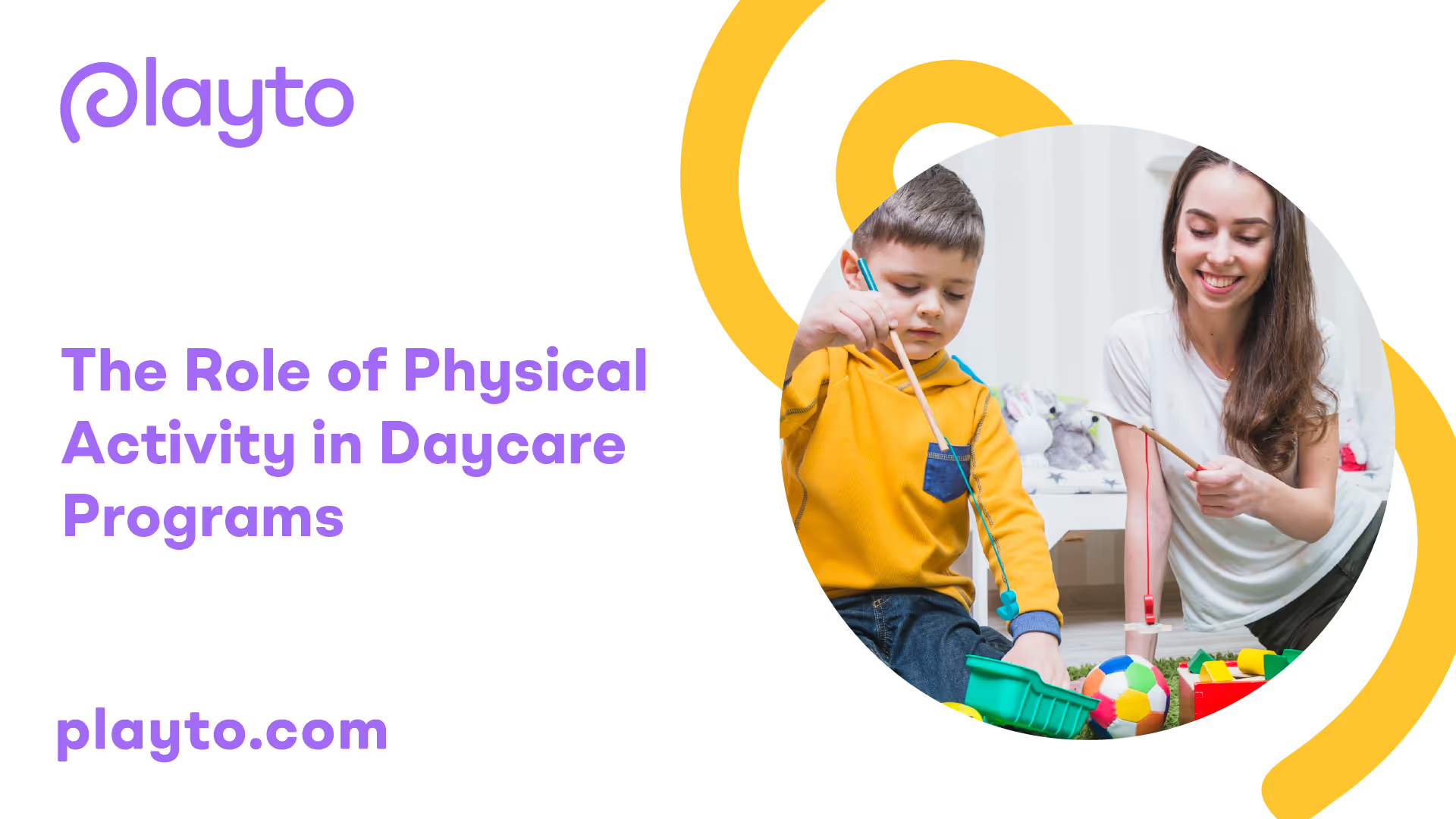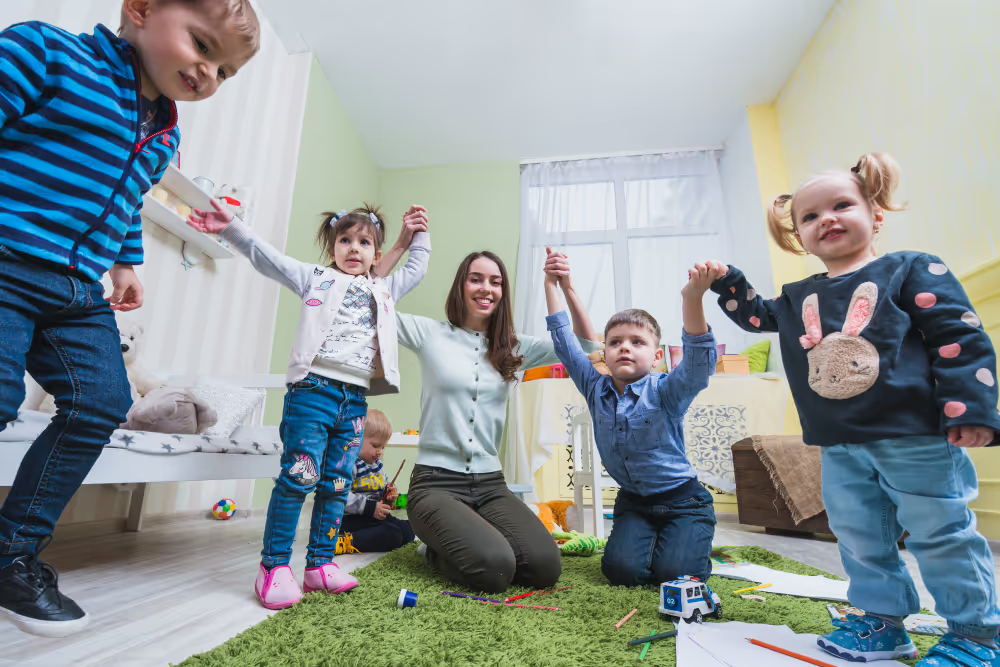Importance of Physical Activity in Daycare Programs
Physical activity plays a vital role in daycare programs, offering numerous benefits for the children involved. It not only contributes to their overall health and well-being but also supports their development in various areas. Let's explore the benefits of physical activity and the importance of age-appropriate activities in daycare programs.

Benefits of Physical Activity
Engaging in regular physical activity has both short-term and long-term health benefits for toddlers and preschoolers. It helps reduce the risk of disease, boosts energy levels, and builds stronger muscles and bones [1]. Regular exercise also promotes cognitive function, attention span, and academic performance, enabling children to have longer attention spans, fewer behavioral challenges, and perform better in school. Moreover, physical activity encourages a healthy body weight, supports bone development, and improves sleep patterns in children. It also contributes to heart health, lowers the risk of developing type 2 diabetes, and enhances endurance, strength, and flexibility [2].
Age-Appropriate Activities
When considering physical activities in daycare programs, it is important to provide age-appropriate activities that cater to the developmental needs of the children. For toddlers, activities that focus on building gross motor skills, such as crawling, walking, and climbing, are suitable. As children grow into the preschool years, activities that enhance coordination, balance, and fine motor skills become more relevant. These activities can include running, jumping, skipping, throwing, catching, and kicking balls.
It is crucial to ensure that the activities offered are safe and well-suited for the children's abilities. Supervision and guidance from caregivers or early childhood educators are essential to create a supportive environment that encourages participation and minimizes the risk of accidents.
By incorporating physical activity into daycare programs, children have the opportunity to experience the numerous benefits it offers. From improved health and well-being to enhanced cognitive and social development, physical activity plays a vital role in shaping the lives of young children.
As we explore the impact of physical activity on child development in the next section, we will delve deeper into the cognitive benefits and social-emotional development that physical activity can foster.
Impact of Physical Activity on Child Development
Physical activity plays a crucial role in the development of children attending daycare programs. Engaging in regular physical activity provides numerous benefits that contribute to cognitive development as well as social and emotional growth.

Cognitive Benefits
Physical activities are linked to improved brain function in children, leading to better language skills, faster response to stimuli, strong literacy skills, improved focus, learning ability, memory, and stress management. By embedding physical activities into the day, children's learning experiences are enhanced. Regular physical activity in early childhood has been shown to influence cognitive development, promoting a sense of accomplishment, positive self-esteem, and understanding of concepts like shape, spatial awareness, and directionality. Increased duration and frequency of physical activity have shown significant beneficial outcomes in executive function and language development.
Social and Emotional Development
Physical activity is an important part of play and learning for children, helping them develop language, social, and communication skills. It also serves as a way for children to build relationships within their family and community when done with others. Through physical activity, children learn to take turns, cooperate, and problem-solve, fostering important social skills. It provides opportunities for children to interact, make friends, and develop healthy relationships with their peers. Physical activities also help with conflict resolution and can lead to improved relationship-building [2].
It is essential to note that physical activity is beneficial for all children, including those with disabilities. Many sports and physical activities can be modified to allow full participation and inclusion for children with disabilities, ensuring that they also reap the cognitive and social benefits of engaging in physical activities.
By incorporating physical activities into daycare programs, children have the opportunity to develop their cognitive abilities, enhance their social skills, and foster a positive sense of self. It is important for daycare providers and parents to recognize the importance of physical activity in supporting overall child development.
Role of Parents in Encouraging Physical Activity
Parents play a crucial role in encouraging and promoting physical activity in daycare programs. Their involvement and support can significantly impact the activity levels of children. Let's explore two important aspects of the role of parents in fostering physical activity: parent-child activity levels and modeling healthy behaviors.

Parent-Child Activity Levels
Numerous studies have shown that parent and child activity levels are closely related NCBI. When parents engage in physical activities with their children, it not only promotes bonding but also encourages children to be more active. By participating in activities together, parents can serve as positive role models and inspire their children to adopt active lifestyles.
Daycare programs can encourage parents to participate in activities during drop-off or pickup times. This can involve simple exercises, such as stretching or walking, that parents can do alongside their children. By incorporating these activities into their routine, parents can set the stage for an active and healthy lifestyle for their little ones.
Modeling Healthy Behaviors
Children learn by observing and imitating their parents' behaviors. When parents model healthy behaviors, such as engaging in regular physical activity, children are more likely to follow suit. By embracing an active lifestyle themselves, parents can instill the importance of physical activity in their children from an early age.
Daycare programs can collaborate with parents to provide resources and information about the benefits of physical activity. This can include sharing ideas for active family outings, recommending age-appropriate activities, and suggesting ways to incorporate physical activity into daily routines.
By involving parents in the promotion of physical activity, daycare programs can create a supportive and collaborative environment that fosters healthy habits. When parents and daycare providers work together, children are more likely to experience the benefits of regular physical activity.
To learn more about promoting physical activity in daycare programs, you may also be interested in our articles on the role of music in daycare programs, the role of pretend play in daycare settings, and the role of music and movement in daycare programs.
Implementing Physical Activity in Daycare
To create a well-rounded daycare program, it's crucial to incorporate physical activity as an essential component. By providing opportunities for children to engage in physical play, daycare programs contribute to their overall development and well-being. In this section, we will explore the implementation of physical activity in daycare through structured vs. unstructured activities and outdoor vs. indoor play.
Structured vs. Unstructured Activities
When planning physical activities for daycare, it's important to consider both structured and unstructured play. Structured activities involve planned exercises and games with specific goals and rules. These activities are designed to develop specific skills, coordination, and teamwork. Examples of structured activities include organized sports, relay races, and dance classes.
On the other hand, unstructured activities offer children the freedom to explore and engage in play without rigid guidelines or rules. Unstructured play encourages creativity, imagination, and problem-solving skills. It allows children to follow their own interests and develop their physical abilities at their own pace. Examples of unstructured activities include free play with blocks, dress-up, and pretend play.
By incorporating a combination of structured and unstructured activities, daycare programs provide a balanced environment that promotes physical development, creativity, and social interaction. It is important to tailor the activities to the age and developmental stage of the children to ensure engagement and enjoyment.
Outdoor vs. Indoor Play
Both outdoor and indoor play have their own benefits and contribute to the overall physical development of children. Outdoor play offers unique advantages, including exposure to fresh air, Vitamin D from sunlight, and ample space for unrestricted movement. Research shows that providing at least 30 minutes of outdoor playtime is crucial for preschoolers to meet recommended levels of physical activity. Moreover, children tend to engage in physical activity for longer durations when playing outdoors compared to indoors.
However, indoor play also holds importance, especially in situations where outdoor play may be limited due to weather conditions or other factors. Indoor play areas can be designed to promote physical activity and include age-appropriate equipment such as climbing structures, soft play areas, and dance mats. By providing a safe and stimulating indoor environment, daycare programs can ensure that children remain active even when outdoor play is not possible.
To strike a balance, daycare programs should aim to offer a mix of outdoor and indoor play opportunities. Planning regular intervals of unstructured playtime for toddlers in daycare is recommended, with the goal of providing at least 60 minutes of physical activity per day. This can be achieved through a variety of activities that cater to the interests and abilities of the children.
By implementing both structured and unstructured activities, as well as providing opportunities for outdoor and indoor play, daycare programs create an environment that supports children's physical development, fosters social interaction, and enhances their overall well-being.
Programs Promoting Physical Activity in Daycare
To ensure that children in daycare programs engage in regular physical activity, various programs have been developed to promote and support their active lifestyles. Two notable programs in this regard are the Play Active Program and meeting national quality standards.
Play Active Program
The Play Active Program, developed by the Telethon Kids Institute, aims to increase physical activity levels among children while they are in daycare. This evidence-based program provides guidance, training, and support to early childhood education and care (ECEC) centers. The Play Active Program includes the following components:
- Physical Activity Policy Template: The program offers a template for a physical activity policy that ECEC centers can adopt. This policy helps create an environment that prioritizes and encourages physical activity among children.
- Resource Guide: The Play Active Program provides a comprehensive resource guide with practical tips and strategies for educators. It offers ideas for age-appropriate activities, guidance on creating active play environments, and suggestions for engaging children in enjoyable physical activities.
- Training for Educators: Face-to-face and online training sessions are available to educators to enhance their knowledge and skills in promoting physical activity. These training sessions equip educators with evidence-informed strategies to incorporate physical activity into daily routines at daycare.
The Play Active Program helps ECEC services meet national quality standards, such as Quality Area 2.1, which focuses on supporting and promoting each child's health and physical activity. By implementing this program, daycare centers can effectively contribute to the physical well-being and development of the children in their care.
Meeting National Quality Standards
In addition to specific programs like the Play Active Program, daycare programs are also encouraged to meet national quality standards to promote physical activity among children. For instance, in Australia, the National Quality Standards, specifically Quality Area 2.1, emphasize the importance of supporting and promoting children's health and physical activity in ECEC settings.
By adhering to these standards, daycare programs ensure that children have access to age-appropriate physical activities, both indoors and outdoors. Providing at least 30 minutes of outdoor playtime is crucial for preschoolers to meet recommended levels of physical activity, especially since many children may not have sufficient outdoor time at home [5]. Daycare programs play a vital role in promoting physical activity among young children, creating a safe and supportive environment for active play.
Educators at daycare centers should choose both structured and unstructured physical activities suitable for children's age and developmental stage. Examples of play-based physical activities include short bursts of energetic play, light intensity active play, and various explorative and imaginative activities tailored to enable all children in the group to participate, including those with disabilities. By incorporating a variety of physical activities into their daily schedules, daycare programs can contribute to the overall health and well-being of the children in their care.
By implementing programs like the Play Active Program and adhering to national quality standards, daycare programs can create an environment that promotes regular physical activity and supports the healthy development of children. These initiatives help ensure that children have ample opportunities to engage in age-appropriate physical activities, both structured and unstructured, fostering their physical well-being and laying the foundation for a healthy lifestyle.
Guidelines for Physical Activity in Children
Ensuring that children engage in regular physical activity is essential for their overall growth and development. Physical activity not only promotes a healthy lifestyle but also contributes to various aspects of their well-being. Here are some important guidelines to consider when it comes to physical activity for children.
Recommended Daily Physical Activity
The recommended amount of physical activity for children varies depending on their age group. According to the Raising Children Network, the guidelines are as follows:
- Children aged 1 year up to 3 years should have at least 3 hours of energetic play each day.
- Children aged 3 years up to 5 years should be physically active for at least 3 hours each day, including one hour of energetic play.
- Children aged 5 years up to 18 years should do at least one hour of moderate to vigorous physical activity plus several hours of light physical activity each day. Additionally, at least 3 days a week, this should include vigorous activities and activities that strengthen muscles and bones.
- Young people aged over 18 years should do 2½-5 hours of moderate physical activity or 1¼-2½ hours of vigorous physical activity per week, or a combination of both, with at least 2 days a week dedicated to activities that strengthen muscles.
It's important to note that these guidelines serve as a general recommendation, and individual needs may vary. It's always a good idea to consult with healthcare professionals or experts for personalized advice.
Providing Opportunities for Play
Physical activity in children is not just about structured exercise but also about play. Play allows children to explore their environment, develop motor skills, and engage in imaginative activities. It is through play that children learn to interact with others, solve problems, and express themselves creatively.
In daycare programs, it is crucial to provide ample opportunities for both structured and unstructured play. Structured activities can include games, sports, and organized exercises that target specific skills. On the other hand, unstructured play allows children to freely explore their surroundings and engage in spontaneous physical activities.
Both indoor and outdoor play have their own benefits. Indoor play can be facilitated through games, dance, and other activities that can be conducted within the daycare setting. Outdoor play, on the other hand, provides children with opportunities to experience nature, enjoy fresh air, and engage in activities that require more space for running, jumping, and exploring.
By providing a balance between structured and unstructured play, incorporating both indoor and outdoor activities, daycare programs can promote physical activity and support the healthy development of children.
Incorporating physical activity guidelines into daycare programs not only benefits children's physical health but also enhances their cognitive abilities, social skills, and overall well-being. By encouraging and facilitating regular physical activity, daycare programs play a vital role in promoting a healthy and active lifestyle for children.
